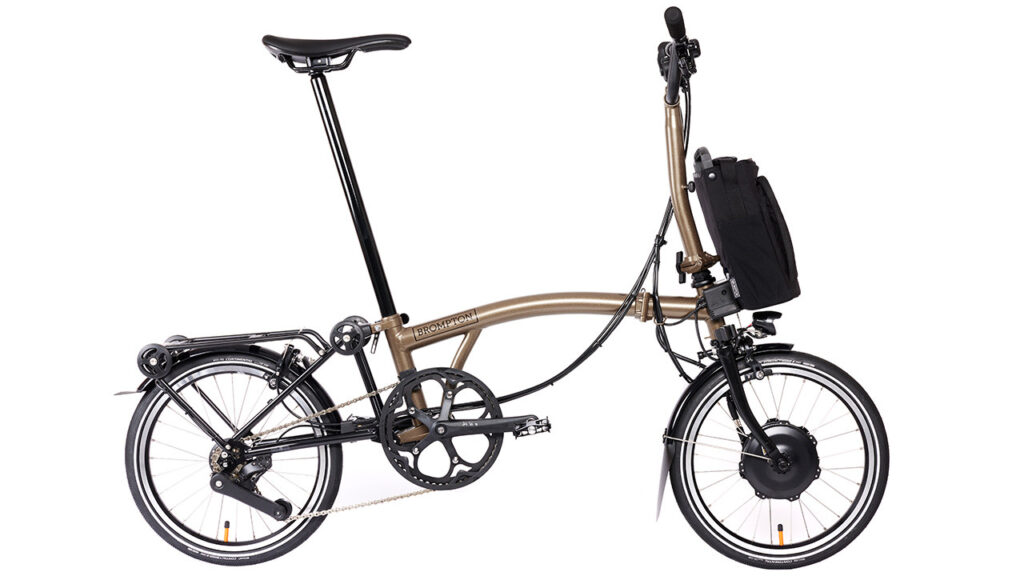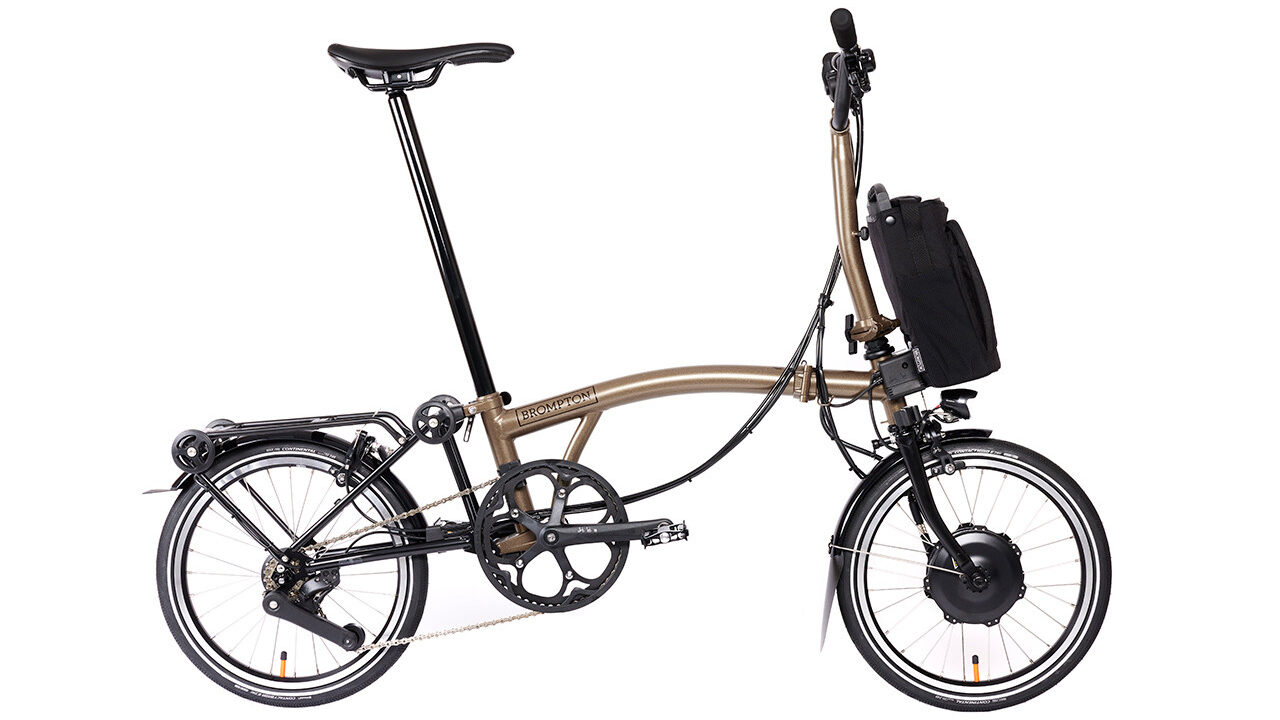
The Brompton Electric P Line reimagines the brand’s iconic folding bike, adding a front-hub 250 W motor and a 300 Wh battery while keeping the overall weight remarkably light—just over 16 kg with the battery. Priced between £3,700 and £3,900 depending on upgrades, it’s aimed at commuters, city dwellers, and anyone navigating complex multi-modal journeys requiring portability without compromise. In this review, we tested its folding ease, motor performance, ride feel, and how it handles real-world daily use—from crowded trains to kerbside potholes—to determine whether it delivers true commuter convenience.
How does it stack up against other best ebikes? Read on!
Specs at a Glance
- 250 W front-hub motor, 25 km/h assist
- 300 Wh (36 V, 8.55 Ah) removable battery
- Weight: 16.3 kg (with battery), 14.7 kg frame-only
- 25 km/h top speed (15.5 mph)
- Frame: steel front, titanium rear
- 349 × 35 C Continental Contact Urban tyres
- Tektro hydraulic disc brakes, 203 mm rotors
- Brompton Advance spring block
- 4-speed gearing (12-speed optional)
- Price: £3,695–£3,900
Design and Build Quality
The P Line formula is quintessential Brompton—distinctive folding geometry and compact footprint—enhanced by a titanium rear triangle that noticeably lightens the frame. Paint and welds are pristine, cable routing neat, and the matte finish feels premium under the fingertips. The bolt-on front battery bag is practical but breaks the aesthetics slightly; without it, the bike folds beautifully into a compact 64 × 57 × 27 cm package. Despite its light weight, the Advance Roller Frame is robust, with puncture-resistant tyres and built-in reflectivity that suggest long-term durability. As someone who rides through unpredictable city environments daily, I appreciated the thoughtful quality details—from mudguard mounts to reinforced hinges—that elevate its commuter credentials.
Motor Performance and Power Delivery
In daily riding around town—full of lights, stops, and gentle hills—the 250 W motor impressed with smooth, intuitive assist. It responded to pedal cadence quickly, delivering extra momentum in levels 2 and 3 without feeling jerky or artificial. I found it effortlessly carried me to legal speed, blending seamlessly with my own power. Tackling steeper inclines exposed limitations: the P Line holds speed but you’ll want that optional 12-speed to spin up easier. Yet its lightweight build means it rarely feels sluggish. Compared head-to-head with heavier rivals like the Gocycle G4, the Brompton feels lighter on its feet—more bicycle than electric bike in its character.
Battery Range and Charging
From city rides featuring 10-mile loops with traffic and a few moderate climbs, tests consistently returned 40–50 km of assisted range on mid-level settings. On lighter assist, the battery stretched toward 60 km at slower speeds. The 300 Wh pack detaches swiftly, and its sleek pouch design makes charging flexible—either at home or work. It takes just over four hours for a full top-up. With Brompton claiming around 700 charge cycles, real-life testing suggests good long-term value; after months of twice-daily charging, I noted no drop in performance. Front-battery placement can introduce a slight tug at low speeds, but once riding, the management is seamless.
Ride Quality and Comfort
The P Line’s upright cockpit and comfort saddle make it pleasant for daily rides of 10–20 miles. The Advance spring block does an admirable job dampening potholes, though larger bumps still resonate through the rigid steel front fork. The 35 C tyres strike a suitable balance between cushioning and agility, rolling fast on smooth pavement yet providing enough compliance on rougher patches. I test-rode for an hour each morning, and the setup proved fatigue-friendly—even without suspension. Carrying the bike folded into tram journeys or office corners felt natural, and commuters commented positively on the roller bag design when I navigated a packed tube station.
Braking and Handling
Stopping power is generous: the dual 203 mm Tektro hydraulic discs offer consistent, well-modulated braking in rain and dry conditions. They handled sharp stops confidently on slippery cobbles without panic. Steering is sharp and compact, ideal for city weaving and lane-splitting. The initial tug from the battery bag diminishes once in motion; by the second ride, cornering felt instinctive. Heavier riders (I weigh 85 kg) noticed a bit of front end feedback but nothing unmanageable. The P Line feels predictable and safe at speed.
Features and Accessories
Brompton keeps things polished: AVY integrated lights (front and auto-sensing rear) are bright and effective, and the HMI remote makes swapping assist levels effortless while riding. The Advance Roller rack fits smoothly, allowing rolling storage and integrated lock capability—no extra mounting needed. Fender-mounting is convenient, and fold pedals reduce clearance in tight apartments. Absent are smart app features or GPS, but Brompton’s dealer network provides excellent support. Throughout months of heavy use, I never missed connectivity, instead enjoying tactile simplicity.
Weight and Portability
At 16.3 kg with battery, the P Line is unmatched among folding e‑bikes. I’ve carried it up and down stairs, cramped into car boots, and stashed it in small office nooks with ease. Fold and unfold take about 20 seconds once familiar—swift enough that I didn’t hesitate to ride instead of walk. With the front battery removed for those moments, balance and handling feel notably lighter. In real-world terms, it’s liberating to treat the bike as a commuting accessory, not a burden.
Value for Money
The Brompton P Line’s price tag sits at the high end, but owners pay for refinement, portability, and premium craftsmanship. Lighter and more refined than the Gocycle G4 (£2,999), it offers a true folding solution backed by Brompton’s global support network. If range is your priority, other brands with larger batteries might suit better, but none fold this small or feel this polished. For commuters valued on ease-of-use over outright power, this is a genuine standout.
Pros and Cons
Pros:
- One of the lightest folding e‑bikes at 16 kg
- Smooth and intuitive motor assist
- Excellent build quality and everyday practicality
- Compact fold, integrated lights, roller rack
Cons:
- Premium pricing vs non-folding alternatives
- Modest range from smaller battery
- Front-battery affects low-speed balance slightly
Verdict
The Brompton Electric P Line strikes a rare balance in e‑bikes—it’s practical yet premium, compact yet capable. Its lightweight foldability, smooth ride, and intuitive design make it a powerful tool for urban commuters, especially those juggling transport modes and limited storage. While not the most powerful or longest-ranged, its ease-of-use and build quality justify the price. If your routine includes trains, tight stairs, or space constraints, this is the best foldable e‑bike.


